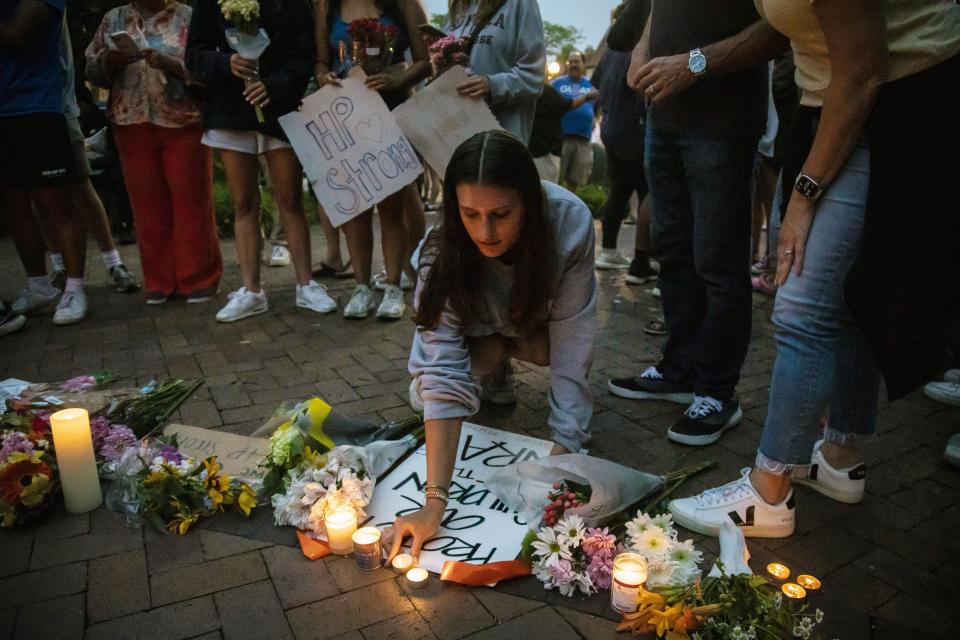Guest editorial: Why the 2nd Amendment doesn't protect the ban on AR-15-style weapons
- Oops!Something went wrong.Please try again later.
Editor's note: Theodore Babbitt is a shareholder of Searcy Denney Scarola Barnhart & Shipley in West Palm Beach and has practiced law more than five decades.
It is past time for Congress to stiffen its spine and revive the national ban on AR-15-style semiautomatic weapons.
If the Independence Day massacre in Highland Park, Ill., was not evidence enough, consider that mass shootings killing or wounding four or more are now everyday occurrences, with more than 300 so far this year.
Gun rights v. gun control: Where do Florida lawmakers stand?
'Our lives are on the ballot': March for Our Lives Parkland rally calls for gun law reform

This weapon of choice for American mass murders is essentially identical to the military’s M16. Its bullet velocity is three times that of a handgun. It decimates human organs and pulverizes bones into dust. One round leaves an exit wound the size of an orange.
Gun advocates insist that the AR-15 is protected by the Second Amendment
The AR-15 killed 58 people and wounded 546 at the Harvest Concert in Las Vegas. It was used in the Parkland school shooting, the Sandy Hook massacre, the Pulse Nightclub in Orlando, the Tree of Life Synagogue in Pittsburgh, in Uvalde, in Buffalo.
Gun advocates insist that the AR-15 is protected by the Second Amendment. This is not true – yet.
Neither the law nor the Second Amendment prevents Congress from banning such weapons. The obstacle is not just public opinion — polls show that far more people support such a ban than oppose it — but failure of political will before a powerful gun lobby and donors, a polarized Congress and a divided and fearful nation in thrall to the Cult of the Second Amendment.
Justice Clarence Thomas does not mention the AR-15 in his June 23 majority Supreme Court opinion in New York State Rifle & Pistol Association v. Bruen. This most expansive interpretation yet of the Second Amendment strikes down restrictions on the ability to carry guns outside the home in New York and five other states. The AR-15 also goes unmentioned in the bipartisan bill signed into law June 25 – the first major gun legislation in nearly 30 years.
There is no reason for a civilian to own an AR-15 other than to kill other civilians. The weapon is useless in hunting because it so decimates the target it renders the meat inedible. Such weapons were indeed banned for 10 years from 1994 until lapsing with little fanfare in 2004. Sales surged.

Gun advocates commonly cite District of Columbia v. Heller, the 2008 case authored by Justice Antonin Scalia. That opinion, which Thomas mentions frequently in Bruen, struck down the District’s banning possession of all handguns by non-law enforcement officials. That law required that owners of firearms of other kinds keep them unloaded, disassembled or locked when not located at a business place or while being used for lawful recreational activities.
It was the court’s first interpretation of the Second Amendment, which states: “A well-regulated militia, being necessary to the security of a free state, the right of the people to keep and bear arms, shall not be infringed.”
Scalia’s opinion in Heller concluded that the Second Amendment did not limit possession of guns to a militia but rather authorized individual ownership by civilians. The opinion concluded that the District violated the Second Amendment because it effectively banned lawful weapons and made other weapons unavailable for self-defense.
However, the Heller opinion, far from protecting a weapon like the AR-15, made clear that such a weapon could not only be regulated but banned once again. Heller specifically affirmed the National Firearms Act’s restrictions on machine guns and sawed-off shotguns, concluding that the Second Amendment does not protect “those weapons not typically possessed by law-abiding citizens for lawful purposes such as short-barreled shotguns.”
Heller makes it clear that the Second Amendment, like most rights, is not unlimited and does not grant the right to keep and carry any weapon in any manner for whatever purpose.
A constitutional “originalist," Scalia sought to hew closely to the framers' original intent to protect weapons “in common use at the time” such as rifles and handguns, certainly not machine guns, sawed-off shotguns, or AR-15s.
This country is awash in 400 million guns for 335 million people, with 20 million AR-15s in circulation. There is now even a children’s version: The Wee 1 Tactical – JR-15, about 20% smaller than the AR-15 with a lighter recoil at half the cost of its big cousin, with a logo of dual boy-and-girl double crossbones with binkies in their mouths, boasting a shooting platform “not only sized correctly and safe, but also looks, appeals, and operates like mom and dad’s gun.”
This is madness. Until the Supreme Court deems otherwise, peddling the fiction that the Second Amendment protects the AR-15 only enables the gun lobby’s deception, thereby accelerating carnage on our streets.
This article originally appeared on Palm Beach Post: Gun control: Ban AR-15 weapons, Second Amendment doesn't protect it

